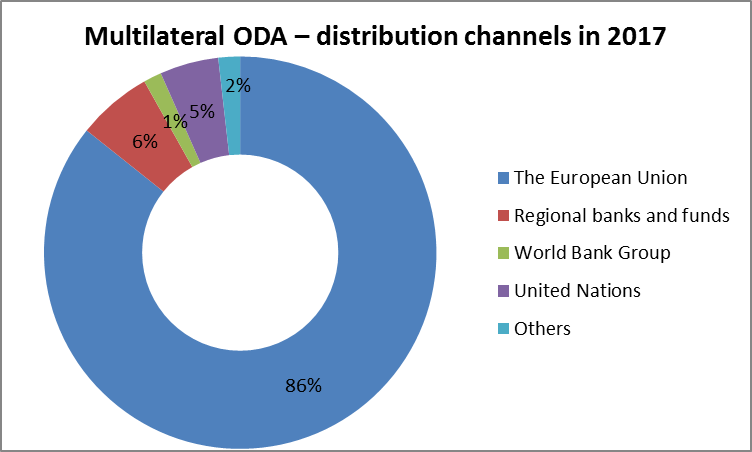Polish Aid 2017 in numbers
In 2017, Poland provided PLN 2.57 billion in official development assistance. Sixty-seven percent of that amount, i.e. PLN 1.73 billion, was spent on multilateral cooperation. Poland allocated PLN 839 million (33 percent) to bilateral aid. Development assistance spending amounted to 0.13 percent of Poland’s gross national income (GNI).
Geographic and thematic priority areas
In 2017, development cooperation was conducted based on the Multiannual Development Cooperation Programme for 2016-2020. Under the programme, Poland pursues development cooperation in line with its geographical and thematic priority areas.
Geographical areas are divided into two groups. The first is made up of four Eastern Partnership countries: Belarus, Georgia, Moldova and Ukraine. In this group, Polish aid aims to support good governance, human capital, entrepreneurship and the private sector, as well as agriculture and the development of rural areas.
The second group includes selected African, Asian and Middle Eastern countries. The group comprises six countries: Ethiopia, Kenya, Myanmar, Palestine, Senegal and Tanzania. Most of them are characterized by a high poverty level. Assistance for those countries aims to support human capital, the protection of the natural environment, entrepreneurship and the private sector, as well as agriculture and the development of rural areas.
Apart from the priority countries, Polish aid is provided to other developing countries, listed below, in line with OECD’s DAC List of ODA Recipients.
Bilateral ODA
In 2017, the main recipients of Polish bilateral assistance were: Ukraine, Belarus, Turkey, Ethiopia, Syria, Lebanon, Tanzania, Iraq, Libya and Moldova (see details below).
|
List of the biggest recipients of Polish ODA in 2017 |
|
||
|
Item no. |
Polish ODA recipient country |
in PLN million |
|
|
1. |
Ukraine |
230.01 |
|
|
2. |
Belarus |
124.77 |
|
|
3. |
Turkey* |
108.49 |
|
|
4. |
Ethiopia |
32.58 |
|
|
5. |
Syria |
19.13 |
|
|
6. |
Lebanon |
18.53 |
|
|
7. |
Tanzania |
16.72 |
|
|
8. |
Iraq |
10.69 |
|
|
9. |
Libya |
10.10 |
|
|
10. |
Moldova |
7.95 |
|
*This includes the contribution to the EU Facility for Refugees in Turkey to support Syrian refugees (PLN 106.72 million)
The largest part of bilateral cooperation was provided through earmarked contributions made to international organisations and assistance funds in the total amount of PLN 402.05 million. A significant amount was allocated to scholarships and estimated education costs financed mostly by the Ministry of Science and Higher Education (PLN 301.40). Over PLN 96 million net was spent on assistance projects. For the first time, the value of loan repayments under tied aid (falling under project assistance) exceeded the payments made via loan agreements (net loans totalled PLN 42.27 million). In 2017, no debt was redeemed.
Poland continues to scale up its humanitarian aid which is mainly addressed to the population affected by the crisis in the Middle East, including the Syrian refugees. In 2017, Poland provided close to PLN 173 million in humanitarian aid, which constitutes a 46 percent increase compared to the previous year.
Calls for proposals
In 2017, the MFA’s Department of Development Cooperation launched six open calls for proposals. As a result, 45 projects received grants totaling PLN 33,023,820, including:
- the “Polish Development Assistance 2017” call for proposals – PLN 19,381,636 (32 projects);
- three editions of the “Securing the funds for own contributions for the implementation of humanitarian projects in the Middle East financed from other sources than the budget of the Republic of Poland 2017” call for proposals – finally no agreement was signed;
- the “2017 Humanitarian Aid in the Middle East and Ukraine” call for proposals – PLN 10,397,987 (eight projects);
- the “Global Education 2017” call for proposals – PLN 250,781 (three projects);
- the “Humanitarian aid in the Middle East aimed at preparing the population for winter 2017” call for proposals PLN 2,993,416 (two projects).
Furthermore, 24 projects totalling PLN 21,326,736 were carried out as part of second modules of the calls for proposals launched in 2016.
Multilateral ODA
The biggest part of Poland’s multilateral development assistance was allocated to the European Union funds for external development assistance. In 2017, the value of Poland’s share in these funds reached PLN 1.48 billion. It was made up of EU budget contribution earmarked for development purposes (PLN 1.18[1]) and the payment (PLN 305 million [2]) to the European Development Fund (EDF), which is the EU’s main non-budgetary instrument used to finance cooperation with African, Caribbean and Pacific (ACP) countries, as well as overseas countries and territories (OCTs).
PLN 84 million was allocated to general budgets of entities acting within the United Nations System, while the World Bank group received PLN 25.5 million. Poland contributed PLN 107 million to regional development banks (most funds went to the Asian Infrastructure Investment Bank (AIIB).
[1] Poland pays one contribution to the EU budget, without any distinction between specific programmes, funds or instruments. Poland’s share in the European Union’s official development assistance is calculated as follows: given the size of the EU’s budget and the amount of Poland’s contribution, it is possible to calculate Poland’s share in the EU budget. Assuming that Poland’s share in the EU’s official development assistance is the same as its share in the entire EU budget, it can be computed based on the data concerning budget implementation. Budget implementation estimates are updated as new reports of the European Commission are released. Therefore, they are subject to significant changes.
[2] The amounts of contributions made by the member states to the European Development Fund are each time specified by the European Commission based on estimated financial needs related to the activities planned as part of a given edition of the Fund. The Funds unused in a given edition are not returned to their contributors. Instead, they are credited towards the amount due for the following Fund edition.
